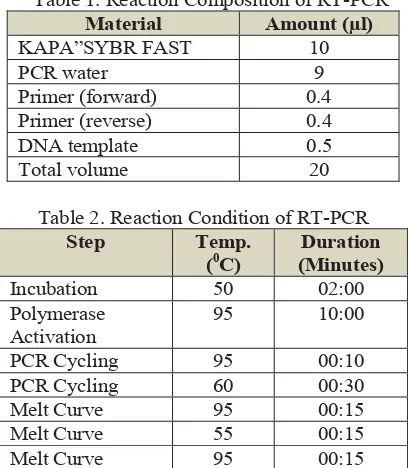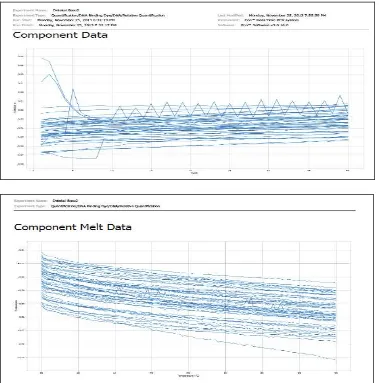BEEF MEATBALLS ADULTERATION TESTS WITH REAL TIME
QUANTITATIVE PCR DETECTION FOR HALAL AUTHENTICATION
- CASE STUDIES SELLERS AT TRADITIONAL MARKET AND SMALL
MEDIUM ENTERPRISES (SMEs) MERCHANTS IN INDONESIA
Lobo Balia ROOSTITA1, Hendronoto Arnoldus Walewangko LENGKEY1, Lilis SURYANINGSIH1, Obin RACHMAWAN1, Wendry Setyadi PUTRANTO1,
Eka WULANDARI1, Gemilang Lara UTAMA2
1
Faculty of Animal Husbandry, Universitas Padjadjaran, Bandung, Indonesia
2
Faculty of Agro-Industry Technology, Universitas Padjadjaran, Bandung, Indonesia Jl. Raya Bandung Sumedang KM. 21, Jatinangor, Sumedang, West Java-Indonesia
Corresponding author email: [email protected]
Abstract
The increase of beef price trigger meatballs adulteration which using pork. Protein specific identification in processed food like meatballs getting difficult because there are possibilities of protein breakdown caused by process. Therefore, molecular approach such as real time quantitative polymerase chain reaction was done to identify pork addition in beef meatballs and give halal authentication as safety warranty to the consumer. Forty eight samples taken purposively from 21 SMEs merchants and 21 sellers at traditional market around Jatinangor education centre. The result shown all the merchant and sellers sold halal beef meatballs, because no adulterated beef meatballs found.
Keywords: real time PCR, pork adulteration, beef meatballs.
INTRODUCTION
Adulteration recently become a serious problem and frequently found in meat and meat products. In 2013, the Food Standard Agency of United Kingdom found 11 from 18 beef lasagna products contained 60-100% horsemeat. British meat industries also threatened by porcine and horse DNA finding in meat samples from three processing plants which two from Ireland and one from Britain. Since that, the scandal spread to 13 European countries includes a variety of findings in others meat products such as beef burgers, bolognese sauces and cottage pies.
In Indonesia, the biggest concerns of meat adulteration findings were in SMEs and traditional market sellers. Lack of capital and knowledge was main reason why adulteration occurs. The high price of meat and passiveness of consumer safety warranty further encourage the SMEs and traditional market sellers to substitute beef with other kind of meat such as pork in the making of meatballs. Pork substitutions in meatball productions were not a crime, however it could generate interest about
non-halal foods especially in Country with most of the population are moslem such Indonesia. Identification of meat adulteration in processed foods as well as meatballs is difficult. The properties of protein used in species identification, often damaged by heat and meatball processing that generate denaturized proteins (Hoffman et al., 1996). Mixed meat or processed meat was complex substrates that need a sensitive assay method to identify the correct DNA target. A specific target sequence could amplify by an optimized PCR procedure, even in a complex genomic sequence (Tanabe et al., 2007). Real-time PCR used as a rapid quantitative detection method to identify pork adulteration in beef meatballs sold in Jatinangor Education Centre, Sumedang District, West Java, Indonesia. Aims of the study were to determine halal authentication of the beef meatballs so that safety warranty of the consumer can be achieved.
MATERIALS AND METHODS
Total 48 beef meatball samples taken from 21 SMEs merchants and 21 sellers at traditional
66
AgroLife Scientific Journal - Volume 3, Number 2, 2014
market around Jatinangor education centre. Samples stored at refrigerator for 12 hours then tested with RT-PCR.
DNA Isolation
Genomic DNA extracted from beef meatballs samples using Pure Link Genomic DNA Kits. A total of 2 g sample entered into the eppendorf tube, add 20 L Proteinase K, 20 L of RNAse, vortex and incubate 2 min at room temperature. Add 200 L GLBB, vortex and incubate at 55°C for 10 minutes. Add 200 L of 95% ethanol and vortex it. Move into spin colums and centrifuged at 12500 rpm, 1 min, RT. Replace with the new collections tube, then add 500 L of WB 1, centrifuged at 12500 rpm, 1 min, RT. Replace collections new tube add 500 mL WB 2, further centrifugation 12500 rpm, 3 min, RT. Replace with a new collections tube and add GEB 200 L, RT incubation for 1 minute later centrifuged at 14000 rpm, the DNA genome can be stored at 4°C.
Table 1. Reaction Composition of RT-PCR
Material Amount (μl)
KAPASYBR FAST 10
PCR water 9
Primer (forward) 0.4
Primer (reverse) 0.4
DNA template 0.5
Total volume 20
Table 2. Reaction Condition of RT-PCR
Step Temp.
(0C)
Duration (Minutes)
Incubation 50 02:00
Polymerase SYBR FAST, ddH2O, ethanol 95%, primer with specific gen cyt b GCT GAT AGT AGA TTT GTG ATG ACC GTA (Matsunnaga).
RESULTS AND DISCUSSIONS
Mitochondrial gene such as cyt b DNA sequence that used could restrict the assay sensitivity. As shown in Figure 2, the assay
could determine porcine DNA until 0.001% quantity with great reproducibility (Tanabe et al., 2007). As shown by the result, curve formed at Figure 1 was different with Figure 2 that mean no porcine DNA sequence amplified from 48 samples of meatball tested. Therefore, no pork added to meatball samples that taken from 21 SMEs merchants and 21 sellers at traditional market around Jatinangor education centre.
Presences of pork in meat and meat products were sensitive issues especially in country with moslem as the biggest population such as Indonesia. Pork is prohibited to consume, because it is not appropriate with halal clause and the consumption of halal foods was compulsory for moslems (Rohman et al., 2011).
Certainty of no beef meatballs adulterated with pork was a good result as base of moslems consumer safety warranty. The results can conclude those 21 SMEs merchants and 21 sellers at traditional market around Jatinangor education centre sold halal beef meatballs.
CONCLUSIONS
Identification of adulterated beef meatballs with pork using RT-PCR give a rapid quantitative result that shown no pork addition in all of the samples. Twenty-one SMEs merchants and 21 sellers at traditional market around Jatinangor education centre sold halal and safe beef meatballs especially for moslems consumer.
ACKNOWLEDGEMENT
Author would like to thank The Research Institute and Community Service of Universitas Padjadjaran for funds and help given.
REFERENCES
Hoffman K., Fisher K., Miller E., and Kemper V., 1996. Experiments to Demonstrate the Effectiveness of Heat Treatments Applied to Canned Meats and Meat-and-Bone Meals. Fleishwirshaft, 76, p. 920-923. Matsunaga T., Chikuni K., Tanabe R., Muroya S.,
Shibata K., Yamada J. and Shinmura Y., 1999. A quick and simple method for the Identification of Meat Species and Meat Products by PCR Assays. Meat Sci., 51, p. 143-148.
Tanabe S., Hase M., Yan T., Sato M., Fujimura T. and Akiyama H., 2007. A Real-Time Quantitative PCR Detection Method for Pork, Chicken, Beef, Mutto and Horseflesh in Foods. Biosci. Biotechnol. Biochem., 71 (12), p. 3131-3135.
Rohman A., Sismindari Erwanto Y. and Che Man Y.B., 2011. Analysis of Pork Adulteration in Beef Meatball Using Fourier Transform Infrared (FTIR) Spectroscopy. Meat Science. (88): p. 91-95.
Figure 1. Result of Real Time Quantitative PCR Pork Adulteration Detection
Figure 2. Amplification Curves of Real-Time PCR Detection for Pork Meat (Tanabe et al., 2007)

